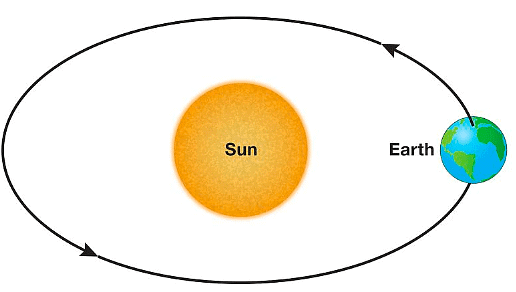Movements of Earth - 2 Class 5 Worksheet SST
Q1: Fill in the Blanks:
(i) The Earth's movement around the sun is called _______________.

(ii) The spinning of the Earth on its axis is known as _______________.
(iii) The Earth's axis is tilted at an angle of _______________ degrees.
(iv) The movement of Earth's axis is responsible for the change in _______________.
(v) The longest day of the year is during the _______________ solstice.
(vi) The shortest day of the year is during the _______________ solstice.
(vii) The equator receives almost _______________ hours of daylight throughout the year.
(viii) The imaginary line that runs from the North Pole to the South Pole is called the _______________.
(ix) The Earth's rotation causes the phenomenon of _______________.
(x) The movement of Earth around the sun causes the change in _______________.

Q2: Multiple Choice Questions (MCQs)
(i) What causes day and night on Earth?
(a) The movement of clouds
(b) The rotation of Earth on its axis
(c) The movement of Earth around the moon
(d) The rotation of the moon
(ii) Which season is experienced in the Northern Hemisphere when it's summer in the Southern Hemisphere?
(a) Spring
(b) Autumn
(c) Winter
(d) Summer
(iii) The imaginary line that divides the Earth into Northern and Southern Hemispheres is called the ___________.
(a) Prime Meridian
(b) Equator
(c) Tropic of Cancer
(d) Tropic of Capricorn
(iv) During which movement of Earth do we experience different lengths of daylight and darkness?
(a) Revolution
(b) Rotation
(c) Tilting
(d) Spinning
(v) What causes the change of seasons on Earth?
(a) Changes in Earth's magnetic field
(b) Distance from the sun
(c) Tilt of Earth's axis
(d) Rotation of the moon
Q3: True and False
(i) The Earth's axis is tilted, causing different seasons.
(ii) The equator receives the same amount of daylight throughout the year.
(iii) The movement of Earth around the sun is called rotation.
(iv) The Arctic Circle experiences 24 hours of darkness during the winter solstice.
(v) Day and night are caused by the Earth's revolution around the moon.
Q4: Match the Following
(i) Summer Solstice → (a) Equal daylight and darkness
(ii) Equinox → (b) Longest day of the year
(iii) Tropic of Cancer → (c) Shortest day of the year
(iv) Winter Solstice → (d) Imaginary line at 23.5°N latitude
(v) Day and Night → (e) Earth's axis is neither tilted nor away
Q5: Short Answer Questions
(i) Explain why different parts of the Earth experience different seasons.
(ii) What is an equinox? Describe what happens during an equinox.
(iii) How does the tilt of Earth's axis cause the change in day length during different seasons?
(iv) What is the significance of the Tropic of Cancer and the Tropic of Capricorn?
(v) Describe the differences between the summer solstice and the winter solstice.
The solutions of the worksheet "Movements of Earth - 2"
|
29 videos|226 docs|48 tests
|
FAQs on Movements of Earth - 2 Class 5 Worksheet SST
| 1. What are the main movements of the Earth? |  |
| 2. How does the rotation of the Earth affect us? |  |
| 3. What is the significance of the Earth's revolution? |  |
| 4. What is the difference between rotation and revolution? |  |
| 5. How do the movements of the Earth impact climate? |  |

|
Explore Courses for Class 5 exam
|

|

















